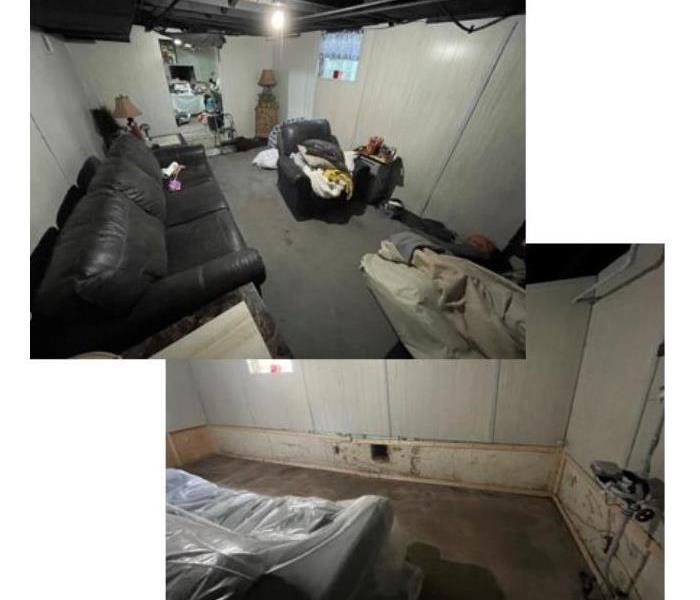Recent Storm Damage Posts
Helping Outside Our Neighborhood
10/27/2023 (Permalink)
Although we are consistently looking to help those in our neighborhood, we are always looking outside our realm to those who need assistance in drastic times, and out-of-the-norm circumstances. This is where our Storm Team comes in and travels to where you are and help in emergency situations for water damage cleanup.
When SERVPRO first gets word of a storm on its way, our crews immediately activate to check inventory, vehicle status, equipment counts, and are waiting on their toes for the dispatch request to jump into action. No matter the time of day or night- we will be headed your way with all the necessary items to assist in water damage and cleaning claims with our highly trained and efficient storm team crew members.
Our Storm Team is certified in water restoration, structural drying, and commercial cleaning services which will help provide the best outcome in such a challenging time. We will work with your insurance companies to submit claim documents, photos, reports, and keep them updated on the status of the project. With our storm crew and office staff working around the clock, you can ensure you will be in touch with the best in the business! See below a great example of our team identifying damage, removing affected materials and drying out the structure- as our team just returned from Storm Travel in Michigan and Ohio!
Traveling for storm may be a lot of work, but nothing is better than getting to reach customers outside your network, providing services in a challenging time, and knowing you are helping those in need. Storm travel means all hands-on deck, even for those working back in the home territories to continue the day-to-day operations, helping the local customers as well as aiding the storm travel crew to keep them busy and ensuring great communication for all parties. Whether you are local to us or in need of services in a storm situation- call the leaders in the mitigation field! SERVPRO- “Like It Never Even Happened”.
How To Maintain Your Commercial Generator
8/20/2022 (Permalink)
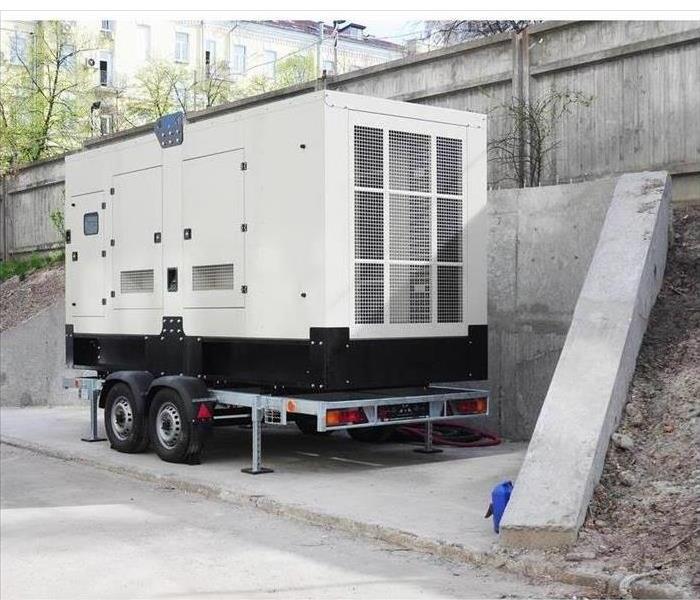 Keep your commercial generator well-maintained so that it works well when you need it most
Keep your commercial generator well-maintained so that it works well when you need it most
A commercial generator provides emergency power to your building when the power goes out. A standby unit turns on automatically during an outage. Commercial machines typically run on either propane or natural gas, so you don't have to worry about refueling them. The average machine lasts about 3,000 hours, but it requires regular maintenance to keep it running smoothly.
Keys to Maintaining Your Equipment
Semi-annual service is critical to keep your equipment functioning properly and to avoid generator problems. A good rule of thumb in Gilberts, IL, is to have it serviced in the spring and fall so that you stay on a regular schedule. If you have a maintenance staff to handle mechanical duties, they can perform the checks. Otherwise, it's smart to find a certified mechanic to help. Typical maintenance includes the following:
- Change serviceable parts as needed. Air filters, spark plugs and fuel filters must be changed according to the manufacturer's instructions.
- Check oil levels and replace engine oil regularly. Keep levels close to full, but don't overfill.
- Clean the battery on your generator often to keep it free from corrosion. Make sure all connections are tight as well. Test the battery to make sure it is working properly.
- Inspect the drive belts for cracks or tears and replace as needed.
- Check the alternator and transfer switch for any signs of damage.
- Clean dirt, leaves and other debris from around the unit.
If your equipment malfunctions and your building floods, call a water damage repair service right away.
Tips for Running a Test Cycle
Many units are designed to automatically run a test cycle on a regular basis. This keeps the system well-lubricated and helps to burn off any moisture. It also recharges the battery. If your unit doesn't come equipped with this feature, run it manually for at least a half-hour every month.
Keep your commercial generator well-maintained so that it works well when you need it most.
Preparing Your Home for Flood Damage
7/20/2022 (Permalink)
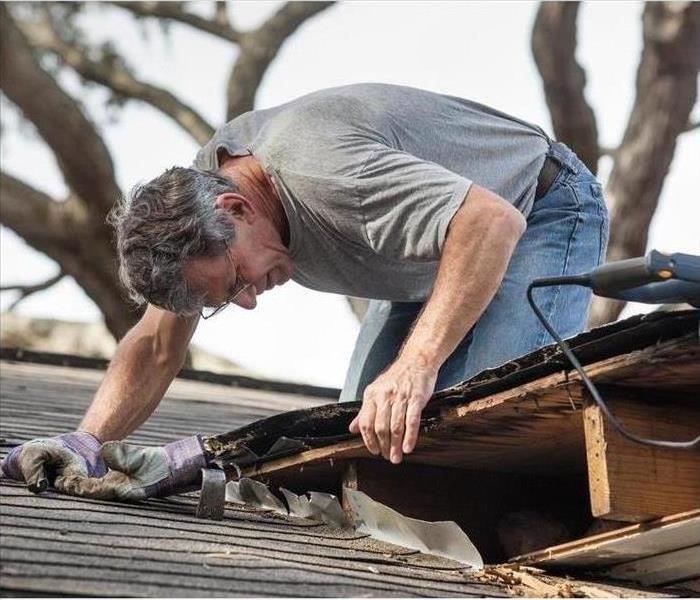 Have your roof inspected
Have your roof inspected
4 Ways to Avoid Flooding and Damage to Your Home
Imagine a fierce rainstorm pounding outside your home in Barrington Hills, IL, waking you from your sleep. You decide to get up to get a snack from the kitchen, but when your bare feet touch the carpet in the hallway, you discover it’s soaking wet, and your linoleum floor in the kitchen is covered in standing water. Could these raging waters have been avoided? Possibly. Here are four ways to avoid flooding and the damage it can bring.
1. Take inventory of your possessions.
Make a list of your personal belongings, supported with photographs and/or video. This will be valuable in the event you have to report an insurance claim for flood damage. This inventory should be stored in a waterproof container, with a backup copy in a secure off-site location, such as a safe deposit box.
2. Have your roof inspected and repaired if necessary. It is a good idea to have a reputable roofing contractor inspect your roof for any hidden leaks and make any necessary repairs. This can prevent you from having to make costly repairs at a later time, such as after flooding.
3. Have your trees trimmed. To prevent storm damage caused by overhanging tree limbs blowing against your house, have your trees trimmed ahead of time. Remove any dead limbs or trees. They are more likely to be broken during a storm, leading to damage to your home.
4. Make sure gutters and downspouts are cleaned. Your gutters should be cleaned and any leaks repaired. Check gutters regularly to make sure they are draining properly. Downspouts should be inspected and any clogs removed. To make sure rainwater is directed away from your home, use splash blocks or downspout extension pipes.
Hopefully, your home will never be devastated by flooding. Being proactive and taking steps ahead of time to prepare your home is a decision that can pay off in the long run. In the event that your home does take damage, however, an emergency restoration company can help you in the storm's aftermath.
Do I Really Need a Flood Cut to Fix My Wall?
6/26/2022 (Permalink)
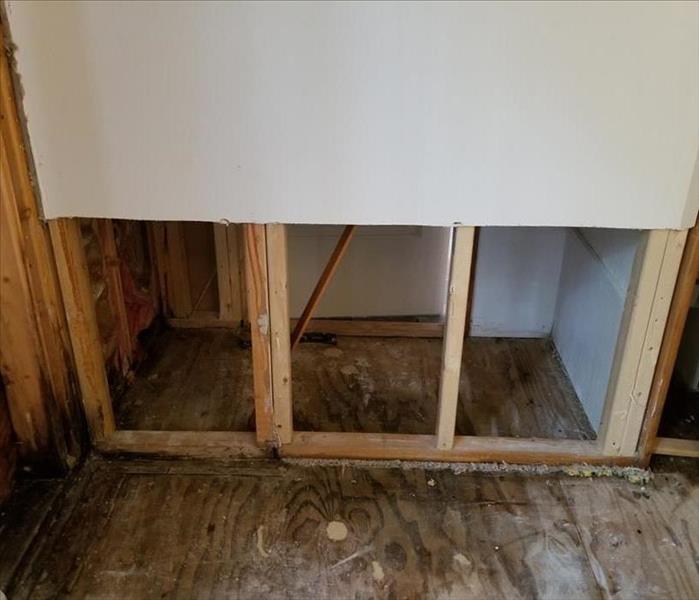 A flood cut was performed on a property in West Dundee, IL.
A flood cut was performed on a property in West Dundee, IL.
When working with a contractor to restore your property after flooding, you often hear different terms and procedures that don’t make a lot of sense. One of the most common is a flood cut. What does it mean? Should my cleanup team be offering one? Knowing the answers to these and other questions surrounding this type of tear out procedure can help you choose the right flood restoration professionals for your West Dundee, IL, property.
What is a Flood Cut?
The term simply means a contractor will cut water-damaged drywall from walls or other areas on your property. The process lets your cleanup partner locate and address any extra moisture behind the walls. Such moisture can lead to:
How It’s Done
First, professionals will examine your walls for signs of water damage such as warping or even early mold. Next, they will cut into the wall, roughly 12-18 inches from where the flood damage happened, and remove a piece of the wall. Next, steps will be taken to dry or replace insulation, depending on the level of damage, before the wall is repaired.
When is it needed?
A flood cut is not required if the wall is damaged by clean water. Unfortunately, flooding is typically associated with contamination by human waste or pathogens. In those cases, leaving wet insulation can result in not only structural damage, but actual illness. Flood cutting can also be avoided if there isn’t insulation behind a wall, in which case less invasive methods may be used.
Cutting into your drywall may seem like a dramatic response for a little flooding. But doing it now can save you a lot of extra expense when you’re facing mold or worse down the road. Consult with a skilled flood mitigation expert to learn whether a flood cut, or other process is key to getting your property back to normal.
How To Avoid Damage From Standing Water Following a Flood
4/17/2022 (Permalink)
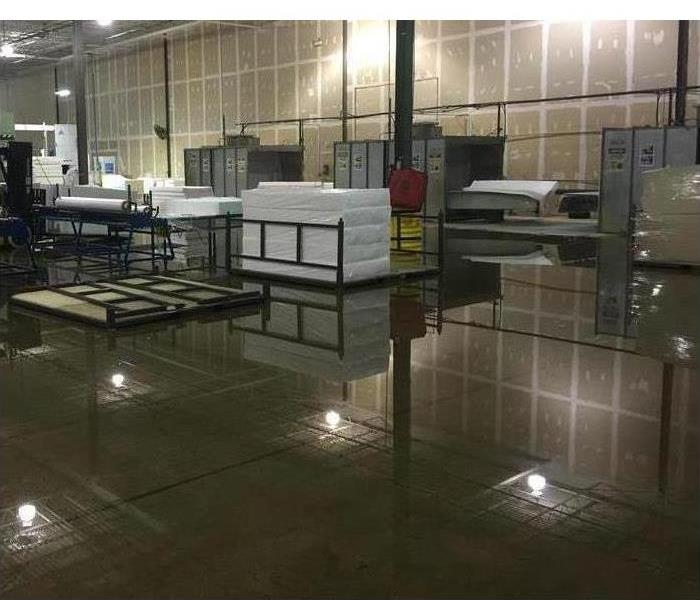 A flooded commercial building in Gilberts, IL.
A flooded commercial building in Gilberts, IL.
Mold growth can occur quickly if excess water is not promptly removed following a flood at your business in Gilberts, IL. You may find yourself tackling mold and other problems in as few as 24 hours if you fail to dry out your space thoroughly.
What Can Cause Standing Water?
Water stagnating inside your business can happen due to various circumstances, including:
- Severe storms
- Water used to put out a fire
- Burst pipes
- Clothing or dishwashing machine leaks
- Faulty sump pumps
Depending on a flood's water source, you may also need to contend with contamination and other complications.
What Does Water Damage Cleanup Involve?
Large volumes of stagnant water require a flood restoration company to perform water extraction using a powerful water vacuum. This crucial step following a flood can minimize mold growth and the spread of bacteria.
If mold is already starting to form, containing it is crucial. For mold spores in the air, creating a negative air chamber achieves containment by allowing more air to leave the environment than enter it. This process also involves adding physical barriers around an affected space to prevent mold spores from progressing to unaffected areas.
Air filtration is another measure to remove lingering mold spores from the air. Powerful machines draw contaminated air through HEPA filters and purify it before returning it to the environment.
For floods involving water contaminated with bacteria or other biohazards, a professional cleaning service can use the appropriate protective equipment and procedures to handle and disinfect your property. It is important to remember that it may not be possible to salvage all property affected by mold and other contaminants.
Mold growth and contamination can be serious consequences of standing water in your business following a flood. Fortunately, a local flood recovery service in Gilberts, IL, knows how to restore your space to pre-flood conditions and can salvage as many of your items as possible.
3 Tips for Protecting Your Home From a Flood
3/31/2022 (Permalink)
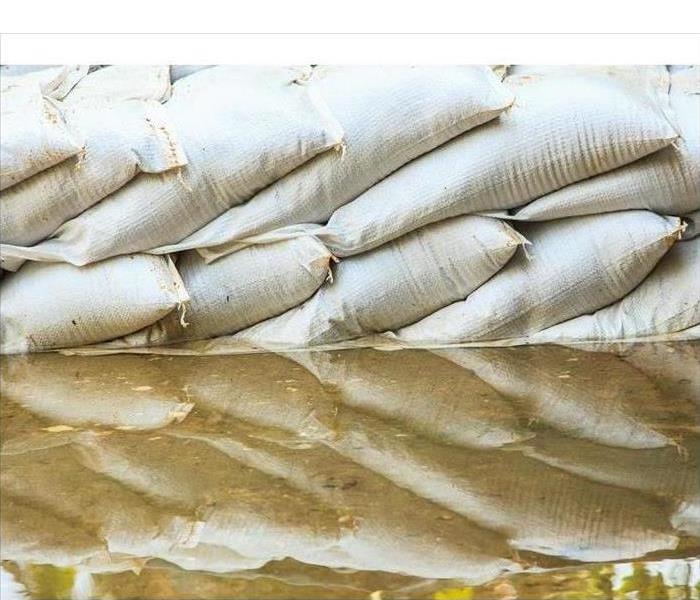 Keeping sandbags on hand might prevent water levels from rising and entering your property.
Keeping sandbags on hand might prevent water levels from rising and entering your property.
Flood Safety Tips
Flooding can cause serious damage to your East Dundee, IL, home. Standing water, mold and other types of problems are likely to result in both lost time and money. While it can be difficult to predict floods, especially those caused by violent weather, there are a few flood safety tips you can keep in mind when attempting to protect your home from such an event.
1. Keep Sandbags on Hand
If you live in an area that floods often, it is wise to keep items on hand that can help you protect your home. For example, keeping sandbags on hand might prevent water levels from rising and entering your property. You can either make these bags yourself or obtain them through a few local government offices during flood season. Place sandbags around your home’s foundation and in low-lying areas to keep floodwaters at bay.
2. Install a Sump Pump in Your Basement
When it comes to flooding safety tips, few are more important than being prepared for basement flooding. When floods occur, the lower levels of your home are likely to be affected first, and a sump pump can prevent standing water and damage to the items you might have stored in your basement. There are many different types of pumps available, including portable models that you can employ in other areas of your home during a flood.
3. Have Your Sewer System Inspected
While it might be difficult to completely floodproof your home, calling in a storm damage and flood mitigation service to inspect and service your sewage system may lower the risk. Flood technicians may be able to either install or advise you on the installation of devices that prevent sewage backflow during heavy flooding. This flood safety tip can help prevent dangerous or contaminated water from entering your home.
When floods occur in East Dundee, IL, the outcome can be dangerous. Learning a few flood safety tips and practicing prevention may be useful when it comes to protecting your home, family and property.
Tips on Dealing With Canceled Flights
1/11/2022 (Permalink)
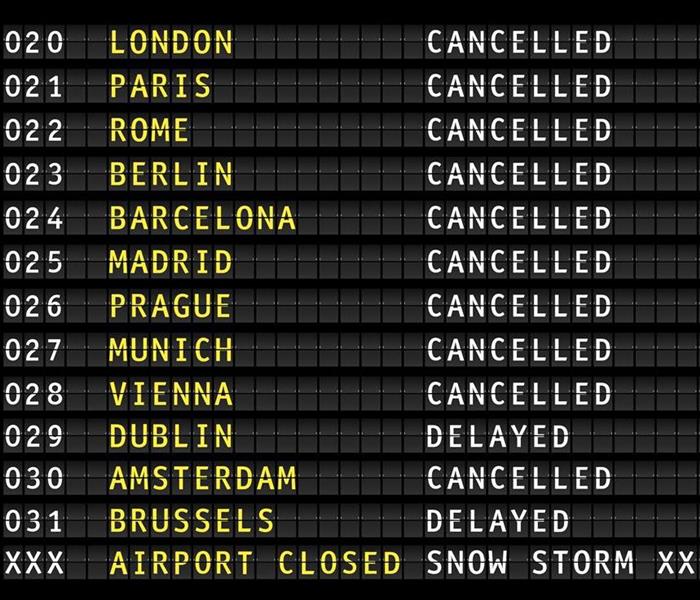 A canceled flight ranks as one of the most frustrating experiences travelers can go through.
A canceled flight ranks as one of the most frustrating experiences travelers can go through.
What to Do If Your Flight Is Canceled
A canceled flight ranks as one of the most frustrating experiences travelers can go through. It happens to thousands of fliers each year and never gets any easier. The best way to be prepared is by having a plan in place.
If storms cause you problems at home in Sleepy Hollow, IL, you can contact specialists to help with the cleanup and address the mess. Traveling is a different beast altogether. What do you do if the weather affects your travel plans?
Planning Ahead
No matter where you are, the best storm tips will always come down to planning:
- If possible, don’t fly at all in bad weather.
- Check weather reports at your current location and where you are landing.
- Consider flying direct instead of making more than one stop to lessen the chance of running into a storm cancellation or delay.
- Try travelling with only a carry-on to avoid the hassle of checked bags if you end up rebooking your flight.
- Always arrive at the airport on time even if there has been a delay.
Contacting the Airline
The moment you hear the announcement that your flight has been canceled, you should immediately call the airline. You might be tempted to stay in line, but contacting the airline directly will take some of the wait and inconvenience out of catching another flight.
Ask your airline if it has a canceled flight policy for placing you on an available seat on the next scheduled flight – even if on a different airline. Be sure to also find out about a possible reimbursement from your airline and other types of assistance it can offer.
Finding a Hotel
If you are unable to be rebooked on another flight immediately, it’s important to seek out a place to stay for the night. When you call your airline, see if it can assist with booking a hotel. There are also apps available that can help you find a nearby room.
A canceled flight is often an inevitable consequence of traveling. Planning ahead and being prepared for possible delays is the best way to avoid a terrible day and get yourself safely in the air once the weather allows for it.
How To Mitigate Roof Damage
9/15/2021 (Permalink)
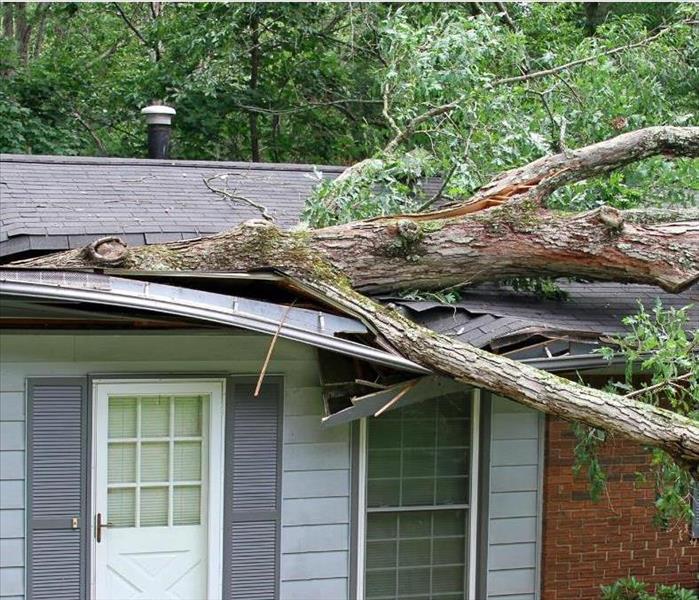 These four steps can minimize the extent of roof damage at your home in Carpentersville, IL.
These four steps can minimize the extent of roof damage at your home in Carpentersville, IL.
Adverse weather or high winds may damage your roof and lead to water damage in your home. Follow these four steps to mitigate roof damage after a storm until roofers arrive.
1. Assess the Damage
As soon as it is safe to access your roof, take a closer look to determine the best approach to limit the damage. The best method depends on the type of roof. Fasten down boards, plastic, or tarpon a shingle roof. Cover leaky spots on tile or metal roofs any way that you can. Sweep standing water off of a flat roof to reduce seepage.
2. Board Up or Use Tarps
You may be able to limit the amount of water or debris that penetrates to the underlayment of your roof or gets into your home by boarding up or covering leaky spots with plastic or tarp. If your home has a pitched shingle roof, use screws or nails to secure the cover. Make sure any material extends over the ridgeline to prevent water from working its way under the covering.
3. Funnel Water Flow
If your ceiling is holding water, situate a large bucket or trash can underneath and pierce the bulge with a sharp object such as a screwdriver or pen. Releasing pooling water can minimize damage. You may need to have extensive roof damage repairs and contact a service specializing in storm damage restoration to prevent mold.
4. Protect Belongings
Take measures to protect interior contents from leaks. Move delicate furniture and items away from the area for the time being. Use buckets or even a large trash can with wheels to catch water and limit the damage.
These four steps can minimize the extent of roof damage at your home in Carpentersville, IL. Whether storm or wind damage is the culprit, you should try to protect your home until roofing experts arrive.
Are Flood Policies Necessary in Low-Risk Zones?
8/12/2021 (Permalink)
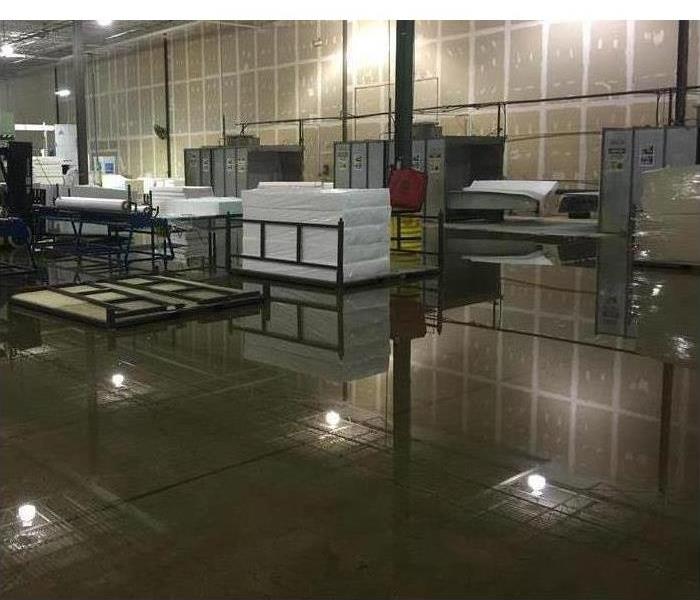 A flooded commercial facility in West Dundee, IL.
A flooded commercial facility in West Dundee, IL.
Are Flood Policies Required in Low-Risk Areas?
Flooding in West Dundee, IL, isn’t isolated to areas within flood zones. For instance, flooding may happen because of heavy spring thaws, uncommon accumulations of rain, and the rapid approach of extra storms after wildfires. It doesn’t take much water to do serious damage. Further complicating the issue of whether to own commercial insurance for flooding are common misconceptions about flood insurance.
- A flood policy isn’t necessary if the business isn’t established in a flood plain.
- Floods and any type of flooding are covered by existing insurance policies.
- Flood policies are all the same and all-inclusive.
- Natural disasters are the only cause of flooding.
Misconceptions To Clear Up
Another serious misconception in West Dundee, IL, is that low-risk flood zones are essentially no-risk zones. Unfortunately, flood maps change as environmental factors change. A commercial property may be outside of a flood zone one year and within a high-risk flood zone within a year. This means that even businesses built on properties outside of flood plains should have a commercial insurance policy for flooding as recommended by FEMA. That policy should be suited to the specific needs of the business and its environment. The policy should also be written to include flooding that takes place due to burst pipes, sprinklers triggered by fire alarms, fast-melting snow, and other emergencies not triggered by a natural disaster.
The Truth About Flooding and Insurance
The truth is that there are different types of policies to cover commercial properties, homes, repair costs, business inventory, and relocation costs. If a business’ insurance company doesn’t require flood insurance, business owners may still want to consider the value of an insurance policy specifically for flooding and water damage. According to FEMA, one inch of water can cost a business tens of thousands of dollars beyond the cost of clean-up services. The annual cost for adequate flood insurance is much, much less than that. When considering whether to purchase a flood policy, business owners should carefully weigh their potential losses against the investment in commercial insurance.
3 Tips for Handling a Canceled Airline Flight During Bad Weather
7/29/2021 (Permalink)
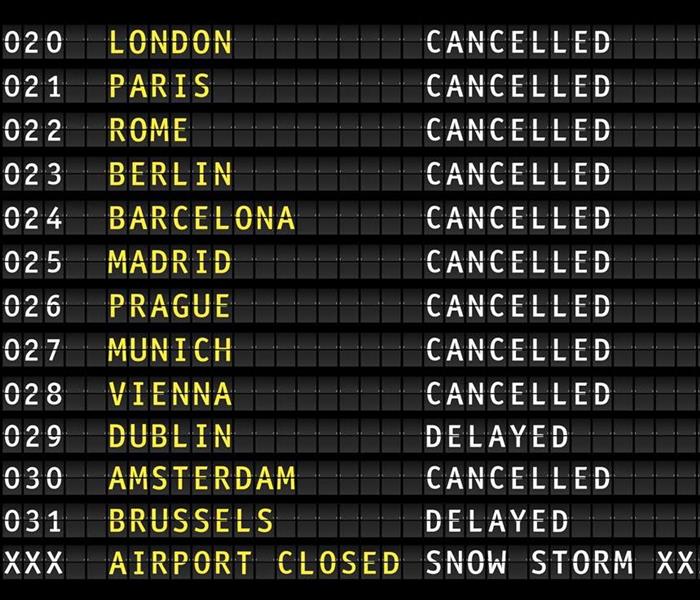 If you receive notification that your flight has been canceled, you should contact your airline as soon as possible.
If you receive notification that your flight has been canceled, you should contact your airline as soon as possible.
Three Pointers for Dealing with a Canceled Airline Flight Due to Bad Weather
Inclement weather can impact your Gilberts, IL, home in a variety of ways, from causing problems with your roof to flooding that requires the help of storm damage and cleanup service once the weather passes. Thunderstorms, freezing rain, and high winds can also interrupt your travel plans, especially if they include airline travel. Facing a canceled flight can be frustrating and worrisome; however, there are a few strategies you can keep in mind for handling this unexpected circumstance.
1. Remain Calm
If your flight gets canceled while you are en route to your final destination, it is important that you stay calm. If you get stranded in a strange city, approach the nearest airline official for advice so you can find out what your options are. Taking the situation one step at a time can help you avoid feelings of panic, which may help others in your traveling party stay calm as well.
2. Contact Your Airline
If you get notified that your flight has been canceled, it is wise to contact your airline right away for further information. Even if the airline representative cannot tell you when the flight will be rescheduled, you can avoid standing in long lines at the airport and bypass the rebooking process. Keeping storm tips like this in mind can make life easier in the wake of a canceled flight.
3. Know Your Rights
Understanding your rights as an airline passenger can make a travel interruption simpler. Review the fine print in your itinerary and talk to an airport representative about securing a meal, a rebooking or even a hotel stay free of charge. The more you know about your rights, the easier it can be to make the delay a bit less frustrating.
Bad weather in Gilberts, IL, can cause a variety of problems, including a delayed or canceled flight. Knowing how to react in this situation can prevent panic and frustration, no matter where you travel.
Important Tips on Commercial Roof Upkeep
5/13/2021 (Permalink)
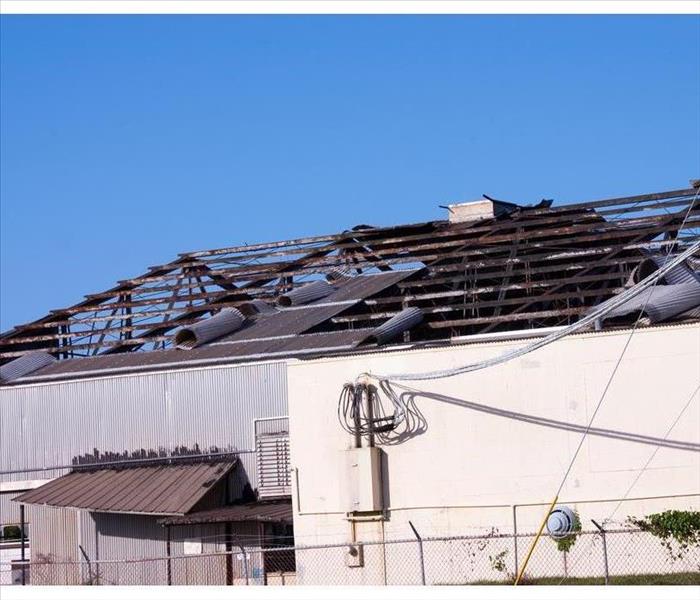 Commercial roof damage in West Dundee, IL.
Commercial roof damage in West Dundee, IL.
If your company experiences roof damage after a powerful storm, it is important to take quick action. A delay could result in additional damage to your facility in West Dundee, IL. If the harm is major, your building could be vulnerable to another downpour. Therefore, a professional storm restoration company might be needed. A trained crew will arrive quickly and assess the situation. If the building is exposed, they could decide to put a tarp over the roof to prevent more rain from coming in. This will secure the building until more permanent repairs can be undertaken.
The Power of Heavy Winds
The winds from thunderstorms often reach well over 60 miles an hour. Tornadoes and hurricanes easily exceed these speeds, sometimes reaching over 100 miles per hour. Roof damage can include torn shingles, damaged gutters and destroyed flashing systems. These situations can expose your commercial building to several expensive situations:
- Roof leaks
- Flooding
- Standing water
- Saturated support boards
No matter where you are located, wind damage is a real possibility. You can minimize the chances of a failing roof by making necessary repairs as soon as problems are discovered. Eventually, a new roof will be needed as most roofs only last from 20 to 30 years. If possible, it is a good idea to budget for a new roof.
The Benefits of a Roof Rebuild
If there is enough damage after a storm, it could be necessary to rebuild parts of the roofing system. A professional team can accomplish this, strengthening your company for the next storm. When it comes to your roof, you always want to make sure the work is done according to the highest standards. This will protect your business and everything beneath the roof.
When strong storms come, roof damage is a possibility. It is always important to make repairs quickly to prevent more damage and to protect your property.
3 Things To Know About Renter's Insurance Coverage of Storms
3/29/2021 (Permalink)
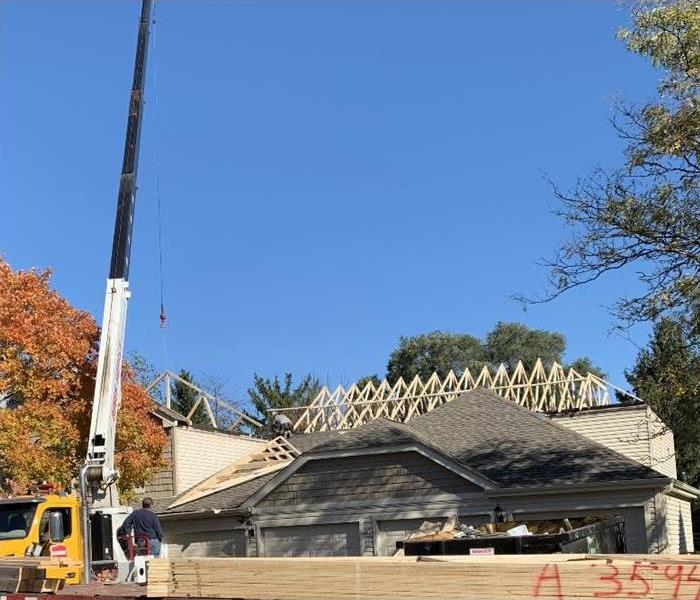 Roof construction in a Carpentersville, IL home.
Roof construction in a Carpentersville, IL home.
If You Rent A Property This Information Is For You
Rental properties aren't immune to damage. Unexpected weather events happen. What exactly are property managers responsible for covering? What does the renter's insurance cover, and what do tenants owe? Regardless of what type of commercial property you own, if you rent it out, this information is for you.
1. Damage from Certain Weather Events May Not Be Covered
Typically, renter's insurance is a requirement for tenants under property management. One of the coverage areas includes storm damage. Do you know the extent of this coverage, however? Generally, this insurance coverage spans issues that arise from natural disasters, including:
- Hail storms
- Wildfires
- High winds
- Rain storms
- Snow and ice
- Lightning strikes
However, there are certain weather events that aren't usually covered. Floods and earthquakes are often excluded. Always check for the local laws and regulations in Carpentersville, IL.
2. Property Owners Are Responsible for the Structure
It's a common misconception that if you are renting, you aren't responsible for any damage that occurs. That is false, especially if you cause the damage. What about natural occurrences that are inevitable? In this case, property owners are only responsible for mitigating damage to the structure. Exterior damage caused by storms calls for local remediation experts to be brought in by the property management.
3. Tenants Are Responsible for the Contents
Renters are required to purchase insurance for a reason. This protects them from unexpectedly losing personal property due to a storm or other natural weather event. While the limits and deductibles may vary, most insurance coverage reimburses tenants for:
- Damage to personal belongings
- Temporary housing expenses
- Interior debris removal
- Food spoilage from power outages
Always check the fine print to determine what the property manager and tenants are responsible for, respectively. Work with remediation specialists that are in tandem with your chosen insurance. You can never fully predict a natural disaster, but knowledge of renter's insurance can help lessen the impact when something does occur.
4 Causes of Sewer Backup in Basements
1/11/2021 (Permalink)
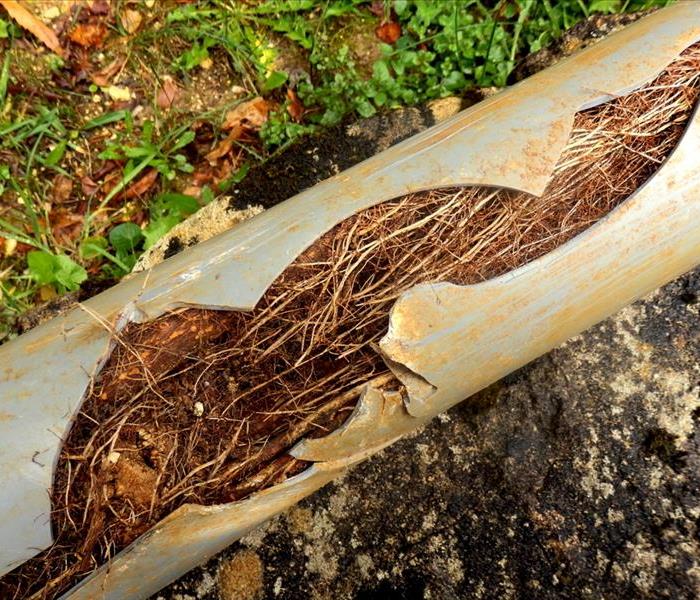 Tree roots are one of the main causes of backups in basements
Tree roots are one of the main causes of backups in basements
Here Are Four of The Main Causes
A flooded basement from a sewer backup can damage property and create safety issues. Understanding the causes of backups in basements can help you avoid them.
1. Clogs
Hair, grease, and other debris can accumulate in sewage lines, causing clogs. If your home's mainline or drain pipes develop clogs, sewage may begin backing up in your basement. If you are noticing slow drains and clogs in multiple areas of your house, this can be a sign that your mainline has a clog that needs to be addressed. Contact a plumber in Carpentersville, IL, to inspect and unclog your pipes.
2. Heavy Rainfall
Heavy rainfall can be a double whammy because it can lead to a flooded basement and overwhelm your city's sewer lines, causing a backup. If you are expecting heavy rainfall, keep a close watch on your basement for flooding or sewage issues.
3. Tree Roots
Roots from trees that are too close to your lines can become entangled. This may cause holes in the lines or crush the lines completely. To avoid this problem, remove any trees on your property that are too close to the lines.
4. Damaged Lines
While modern sewer systems are made of long-lasting plastic pipes, older systems were constructed from cast iron and clay piping. As these older systems age, the pipes can crack and break, leading to sewage backups. If you suspect you have a damaged sewage line, contact the city water department to inspect and repair the line. If a damaged line has caused a flood in your basement, you may need a flood mitigation company to remove the water before it creates additional problems.
To avoid a flooded basement or sewage issue, you should familiarize yourself with these common causes of sewage backups. Have a plan in place to address each of these issues should they occur on your property.
Top 4 Causes of Sewage Backup
10/21/2020 (Permalink)
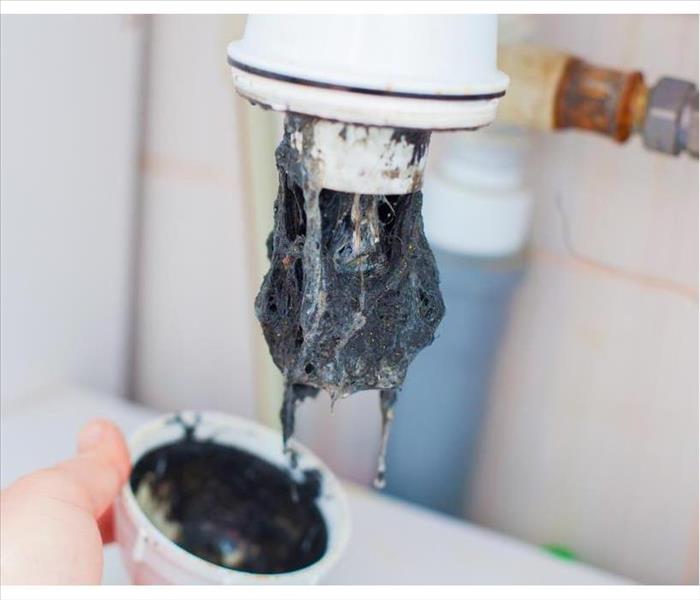 Make sure to check the drain pipes in your home
Make sure to check the drain pipes in your home
Common Causes For Sewage Backup
A flooded basement is problematic enough on its own, but what happens when the cause of that flood is sewage backup? In short, a very expensive and dangerous mess that needs to be taken care of as quickly as possible. In this case, the best way to protect your home in Sleepy Hollow, IL, is to prevent incidents like this from happening in the first place. Knowing the most common causes for sewage floods is the key to protecting your property.
1. Heavy Rain and Severe Storms
Large amounts of water can quickly overwhelm sewer lines. This starts with the main public lines and quickly spreads to the connected residential lines. When this happens, you're likely to experience sewage back flow.
2. Overgrown Tree Roots
Both sewer lines and tree roots are underground, meaning that they can sometimes become intertwined. Overgrown roots can wrap around the sewage pipes, crushing and damaging them.
3. Sewage Pipe Clogs
Everyone experiences minor pipe clogs from time to time. When these clogs become severe, they can ultimately result in sewage backing up into your basement. Make sure to check all the toilet, bathtub and drain pipes in your house. If most of the pipes are experiencing backup, then the clog is likely sourced in the main sewage line. This can also be a sign that your sump pump is failing.
4. Aging or Damaged Sewage Lines
Sewage pipes aren't meant to last forever. Older pipes are made out of cast iron, which tends to break down and crack apart with age. When this happens, a flooded basement is imminent. Luckily, modern pipes are crafted out of plastic, which is less likely to break down over time.
Knowing the most common causes for sewage backup is only the beginning when it comes to protecting your home from falling victim to a flooded basement. You also need to make sure you're implementing the proper preventative measures. Contact flood remediation experts for help.
Commercial Storm Insurance and Hurricane Coverage
9/3/2020 (Permalink)
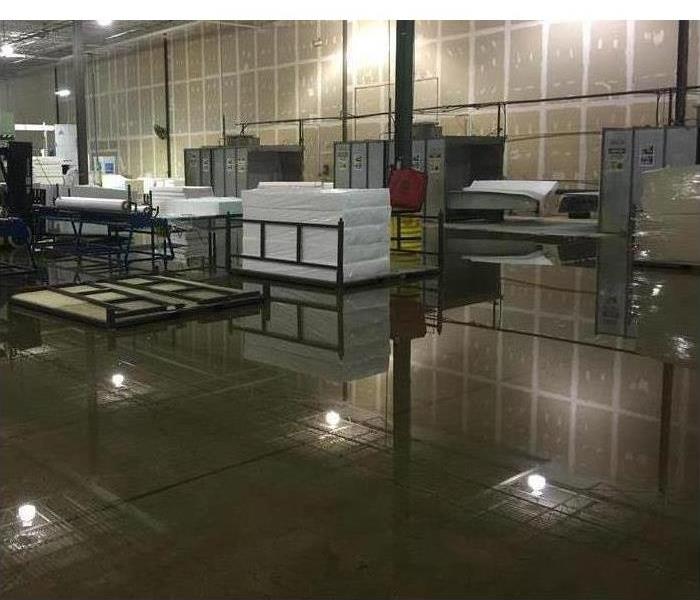 Commercial facility damaged by heavy rains
Commercial facility damaged by heavy rains
Commercial Storm Insurance and Hurricane Coverage
When you think about storm insurance, coverage for rain, and ice damage to your building comes to mind. Yet these are not the only losses that your insurance covers. Your insurer may also help you pay for harm caused by hurricanes or heavy winds.
Hurricane Coverage
The last few decades have seen several major windstorms hit the United States, from Hurricane Andrew in 1992 to Hurricane Katrina in 2005. States near the Atlantic Ocean are particularly prone to hurricanes during the months between June and November. As a result, insurers in Washington, D.C. and the below states now offer hurricane deductibles:
- Alabama
- Connecticut
- Delaware
- Florida
- Georgia
- Hawaii
- Louisiana
- Maine
- Maryland
- Massachusetts
- Mississippi
- New Jersey
- New York
- North Carolina
- Pennsylvania
- Rhode Island
- South Carolina
- Texas
- Virginia
Hurricane Deductibles
If your business is located in one of the above-mentioned states, your policy likely includes some form of wind or hurricane insurance coverage. This storm insurance can help you pay for restoration and cleanup services following a disaster.
However, hurricane coverage includes a deductible. This is the amount that you as the property owner will have to pay before the insurance is applied.
Keep in mind that the event triggering the deductible varies in each state. For instance, in Connecticut the deductible is triggered whenever the National Weather Service indicates a hurricane with winds of at least 74 miles per hour. However, in Maryland, the deductible is applied whenever any part of the state comes under a hurricane warning.
In most states, the insurer determines the amount of the deductible. Check your policy or contact your insurance representative in Gilberts, IL, for more information.
Commercial storm insurance does not just cover rain, snow, and hail. If you live in certain parts of the country, you should have hurricane coverage, as well. While you will still have to pay a deductible, your insurance should greatly reduce the disaster's financial cost to your business.
Why Your Home Needs Protection From the Elements Throughout the Year
8/13/2020 (Permalink)
 Roof inspection in a Sleepy Hollow, IL home
Roof inspection in a Sleepy Hollow, IL home
Why Your Home Needs Protection From the Elements Throughout the Year
If you think that it's the rare blizzard that can cause significant damage to your Sleepy Hollow, IL, home, think again. You may be surprised to know that a massive winter storm is not the only cause of weather-related home damage. Wind and rain throughout the year can contribute to problems leading to the following.
Financial loss
High insurance premiums
Relocation expenses
These parts are especially vulnerable.
Roof
Strong wind gusts can deposit heavy tree branches or drive hail pellets that can weaken shingles and cause holes through which snow or rainwater can leak. It is crucial to inspect suspected roof damage immediately after a powerful storm. Neglecting to do so may lead to costly roof repairs or irreparable damage, especially if stress caused by the next storm is more than what the roof can bear.
Gutters
During a powerful spring or winter storm, gutters may overflow or become dislodged, allowing large quantities of water to enter a home through its foundation, creating a flood. If this happens, it is best to arrange for professional water extraction services as soon as possible to prevent the formation and spread of mold that can spread quickly.
Septic Systems
Heavy storms can saturation the ground around the septic tank outside a home. When this happens, the tank cannot adequately drain into the soil. Instead, the water backs up through the home's plumbing system until it has nowhere to go except out through interior toilets and faucets, resulting in a flood of contaminated water and other particles within the home. Under these circumstances, it is essential to contact a professional cleaning service with the necessary equipment to purify air and surfaces to make the home liveable again.
You can't assume that a spring storm will be less damaging than a winter storm to your Sleepy Hollow, IL home. Regular maintenance will ensure that even minor damage doesn't lead to catastrophe.
Water Damage Cleanup Process
5/1/2020 (Permalink)
 When cleaning up water damage, the first step is to remove the water with a specialized vacuum
When cleaning up water damage, the first step is to remove the water with a specialized vacuum
Water Damage Cleanup Process
Water damage to your Sleepy Hollow, IL, home can lead to mold growth within 24 hours, so it is important to act quickly to prevent further damage. The following steps outline the cleanup process:
1. Contact your insurance company. They are likely to have specific instructions regarding how to document the damage, recommendations for contractors, and other helpful information. Follow any instructions that they give you to avoid having your claim denied.
2. Remove standing water. When cleaning up water damage, the first step is to remove the water. There are pumps and specialized vacuums available for this purpose. If necessary, you can also use buckets to scoop out the water.
3. Dry out remaining water. After the standing water has been removed, there will still be moisture in porous items. You can use fans and dehumidifiers to help dry them out. If the humidity outside is low enough, you can also open windows and doors to increase the airflow. Some items can be taken outside and left in the sunshine to dry.
4. Clean affected areas. Depending on the source, there may be bacteria lurking in the floodwater. Therefore, it is important to properly sanitize all affected items. The source of the water will determine the type of cleaner you should use. Anything that cannot be fully cleaned and dried should be thrown away to prevent mold growth.
5. Repair and replace damaged items. Some repairs you may be able to do yourself. However, for delicate items, such as electronics and antiques, it may be best to hire a specialist who has the tools and training to restore the item properly.
When your home suffers water damage, mold growth is likely to follow if the water is not removed quickly. However, it is easy to become overwhelmed by the cleanup process, especially if the damage is serious. Fortunately, an experienced restoration company can help you get your home back to normal quickly and safely.
Maintaining a Building Envelope
4/11/2020 (Permalink)
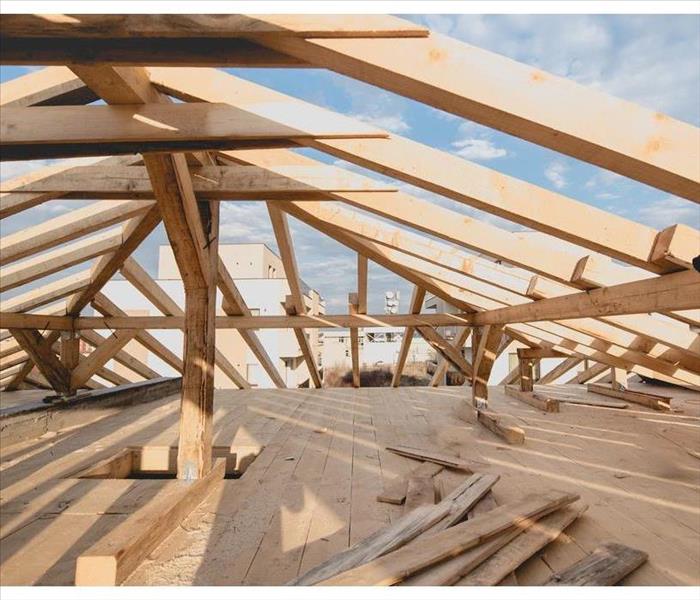 The envelope is composed of all the barriers between the interior and exterior of the building
The envelope is composed of all the barriers between the interior and exterior of the building
Rain damage to your West Dundee, IL, building can lead to serious problems, including black mold. The best way to protect your commercial property is to ensure the building has a sound envelope to keep out rain, wind, and other elements.
Purpose of the Building Envelope
The envelope is composed of all the barriers between the interior and exterior of the building. Major components include the following:
- Roof
- Walls
- Doors
- Windows
- Foundation
Seals around doors and windows are also part of the building envelope. The envelope should provide insulation, control light, and noise that enters the building and keep the interior dry. Envelopes that provide good insulation and moisture control are referred to as tight envelopes. Loose envelopes allow more air and moisture to enter the building. Buildings with tight envelopes are less prone to mold growth, rain damage and other problems. They are also more energy-efficient. However, tight envelopes minimize airflow so it is important to maintain proper ventilation.
Maintaining the Envelope
There are several steps you can take to keep your building's envelope in good shape. Make sure there are no flat areas where water can accumulate, as this will put pressure on the envelope and speed deterioration. Perform biannual inspections to check for cracks and other openings as well as joints that have come apart and sealant that has deteriorated. Do additional checks after major storms. Repair any damage as soon as possible. If you notice mold growth, address it quickly to prevent structural damage. When it is necessary to repair or replace parts of the envelope, invest in quality materials and experienced workmanship. Make sure the materials are appropriate for the weather conditions in your area.
Unfortunately, even buildings with tight, well-maintained envelopes can suffer rain damage. If your business suffers water damage or other issues, a certified restoration service can help you get the structure back to normal quickly and safely.
Effective Ways to Prepare for Flood Damage
11/15/2019 (Permalink)
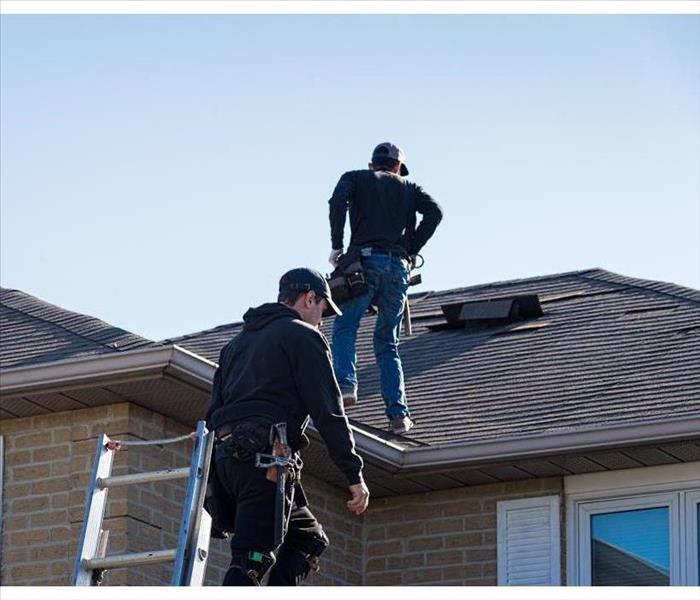 You should inspect your roof at least once a year
You should inspect your roof at least once a year
Effective Ways to Prepare for Flood Damage
Sometimes, life simply happens, and there isn't much you can do to foresee or prevent accidents or disasters. Flooding in your Sleepy Hollow,IL, home can be devastating and sometimes difficult to guard against. Fortunately, there are some steps you can take to reduce your risks.
Inside the Home
Many floods start inside your house due to poorly maintained plumbing or water systems. Over time, materials will break down and eventually fail. It's essential to routinely inspect different areas of your home that could cause flood damage. Some of these include:
- Water heater
- Pipes under bathroom and kitchen sinks
- Toilet
- Entire sewage and plumbing system
Staying on top of maintenance will help ensure the pipes are in good condition. This proactive approach will enable you to spot leaks and identify the possibility of a pipe break.
Outside the Home
Flooding often infiltrates your house from the outdoors. Large storms or main line backups can send water into your basement or through the roof. You should inspect your roof at least once a year. Look for broken or missing shingles, or soft spots. It's also critical to keep rain gutters and downspouts in good condition. Clean out dirt and debris, and replace them if necessary. After a storm, pay attention to how well (or poorly) water is draining away from your home. If it is pooling near the foundation, it could seep into your house and cause storm damage.
Landscape
To keep water from coming into your home, you can try planting trees, bushes and shrubs. Look for plants that naturally absorb water. Also, make sure your property is graded to send water away from your home.
Know the Experts
You should be prepared to call a professional flood cleanup team in case of an emergency. An experienced specialist has the tools and resources to clean up quickly and thoroughly.
You may not be able to stop the rain from coming, but there are things you can do to protect yourself from flooding. Following these tips can bring you peace of mind.
Preventing Rain Damage To Your Commercial Building
10/29/2019 (Permalink)
 Warehouse flooding in Barrington Hills, IL
Warehouse flooding in Barrington Hills, IL
Rain damage to your Barrington Hills,IL, business can cause major problems. However, there are some precautionary measures you can take to prevent this from happening.
How To Protect The Building From Water Damage
The walls and roof of a building form the barrier between the inside of the building and the outdoor elements. This barrier is called the building envelope. Maintaining this envelope is the most important step you can take to prevent rainwater entry to the building. The following are some specific steps you can take to keep the barrier secure:
- Have inspections done twice a year.
- Repair cracked bricks and plaster.
- Replace missing or damaged roof shingles.
- Replace deteriorated sealants.
- Keep gutters in good condition.
- Ensure that the ground slopes away from the building.
A contractor can inform you of any other maintenance tasks that your structure may require.
What To Do If Water Damage Occurs
Unfortunately, even the most well-maintained buildings may experience rain damage. If this occurs, it is important to begin cleanup as quickly as possible in order to avoid black mold and other hazards. Every situation is unique, but the following steps provide a general overview of the water damage restoration process:
- Remove standing water. Depending on the water level, you may be able to use buckets to scoop out the water. Special pumps and vacuums can also be used.
- Dry out remaining water. Dehumidifiers and fans come in handy here. If humidity is low enough outside, you can also open windows and doors.
- Sanitize everything that came into contact with the flood water.
- Repair or replace all damaged goods.
Routine maintenance of the building and quick cleanup of any water can minimize the effects of rain damage to your building. However, you may wish to enlist the help of an experienced restoration team to help get your business back to normal quickly and safely.
3 Essential Tips for Storm Preparedness
9/10/2019 (Permalink)
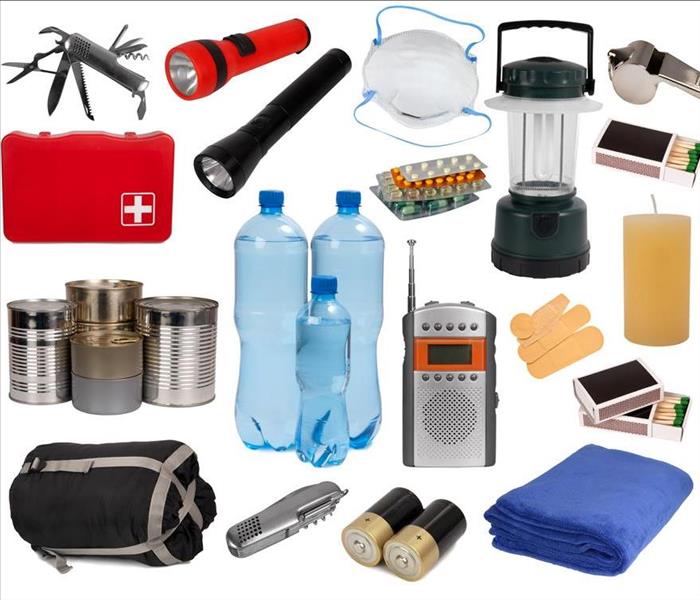 Emergency kit supplies
Emergency kit supplies
3 Simple Ways To Prepare Your Family and Your Home For Extreme Weather
As hurricane season approaches, it is important to have a contingency plan, even if you do not live in an area that is often affected by major storms. Flood water can cause damage to your home and valuables, and even cause harm to you and your loved ones, so it is imperative that you have a strategy in place. Here are three simple ways that you can prepare your family and your home for extreme weather.
1. Put Together an Emergency Kit
This kit should include items such as first aid supplies and essential medications, water, batteries and flashlights. A hand-crank or battery-powered radio is also a good addition, so you can safely monitor storm conditions from inside. The kit should also be waterproof to avoid water damage from potential flood water.
2. Establish an Evacuation Plan
Decide on a meeting point with your loved ones in advance of any weather so that everyone knows where to go in case of a mandatory evacuation. If you have pets, ensure that they are able to come with you so they don’t get left behind in a flooded building.
3. Secure Your Home Inside and Out
Remove anything from the outside of your home that could become a projectile if the winds pick up, such as umbrellas, flags and chairs. Ensure that all of your important documents are in waterproof containers, and make digital copies if possible. Move valuables to high shelves or upper floors in case water creeps into your home. You may require storm damage repair or even mold remediation after the storm, but at least your most prized possessions will be safe.
Being ill prepared for dangerous weather and water damage can be disastrous for your Carpentersville,IL, home and your loved ones. Prepare for flood water in advance so you never have to scramble at the last minute.
The Rules of Storm Damage and Tax Deductions
8/23/2019 (Permalink)
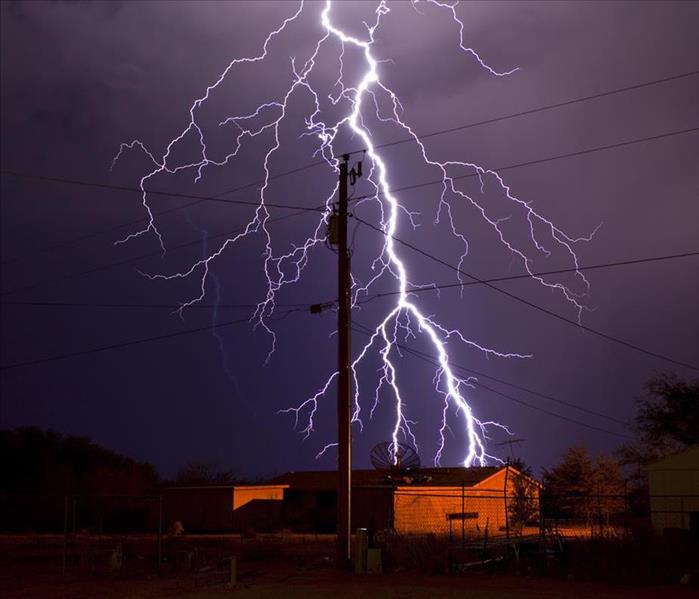 Lightning strikes may cause building fires
Lightning strikes may cause building fires
Are Storm Losses Deductible?
Owning a commercial property and running a business are challenging tasks, even for the most well-equipped and educated people. However, the job of running a business becomes more complicated when a storm wreaks havoc on your building. Despite insurance, the expenses for recovery and restoration of storm damage can throw a wrench into the most organized operations. Therefore, when year's end rolls around and tax season begins, many business owners wonder whether storm losses are deductible, and if so, which ones and how much. Here are some things to take into consideration:
1. No Deductions for Deterioration or Accident Loss
While many losses are tax deductible, you cannot claim losses on deterioration or accidents. Deductions will only help you offset damage caused by natural disasters, not negligence.
2. Deductions for Storm Damage Coverage
Storm damage can come from various causes and produce a variety of losses. For example, lightning strikes may cause building fires, hurricane winds may send debris toward and through windows or heavy rains may cause flooding. All of these issues and the recovery from them can be deducted. However, if you have insurance and fail to make a claim, you cannot claim losses.
3. Universal Deductions for Declared Disasters
Some natural disasters result in universal deductions for the affected area. If the president declares a national disaster in your area of operation, you may be eligible for certain deductions laid out by the government.
4. Deductions for Restoration Work
Once a storm has passed, you may need to contact a storm remediation specialist in the Sleepy Hollow,IL, area to help you salvage your business. While insurers may pay a portion of the recovery and restoration costs, you may have to pay out-of-pocket for a part of the expenses. The portion that you pay can likely be deducted on your taxes.
Storm damage can be catastrophic not only for the damage to your business, but also in expenses for recovery. Be sure to keep your receipts, file your claims and hire a professional to help you rebuild.
What First Responders Need To Know About Floods
7/23/2019 (Permalink)
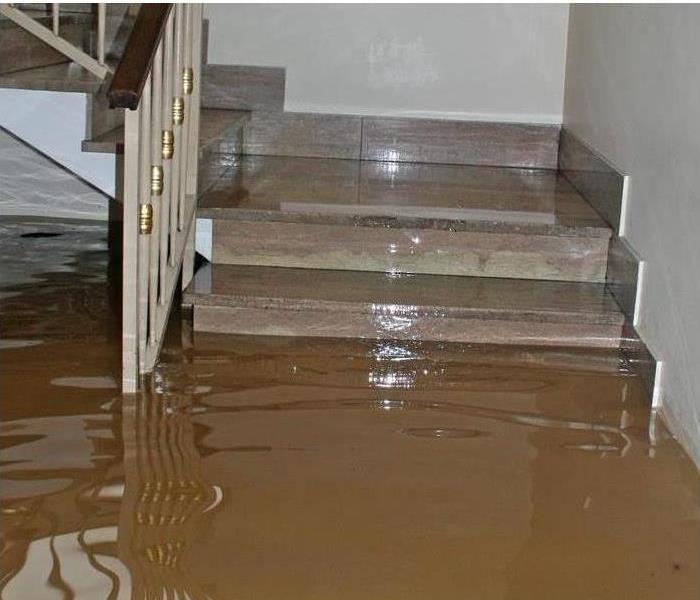 Flood damage in a home due to heavy rains.
Flood damage in a home due to heavy rains.
As a first responder in Carpentersville, IL, you should know what to do before and during a disaster situation to safely and efficiently do the job. Floods, for example, can be caused by multiple sources:
- Thunderstorms
- Burst dams
- Broken pipes
- Leaky appliances
Being able to wisely navigate the different causes and hazards of a flood should increase job efficiency and personal safety.
Personal Safety During Flood Cleanup and Restoration
Being Properly Immunized
Immunizations are often an important defense measure when dealing with floods. A tetanus vaccination can protect against serious bacterial infection, and a booster should be given to adults every 10 years. For people working directly with those exposed to flood contaminants, Hepatitis B is also recommended and is given as a series of vaccinations. There are several other vaccinations that can be helpful, but tetanus and Hepatitis B are typically the most crucial.
Washing Hands
Hand washing, though it seems simple, can be extremely important for a flood response team. Depending on the source of the flood, there could be biological contaminants and mold in the water, and therefore on everything the water gets to. Washing with soap and water is often best, but using a hand sanitizer that is alcohol-based can also work in a pinch.
Wearing Protective Clothing
Eye goggles and gloves are a should-have for a first responder, especially in areas with contaminated water. Clothing that has been treated to be chemical-resistant can also be a good idea, as well as sturdy boots that can handle the terrain. Make sure to launder anything that comes in contact with flood water before returning home, to minimize the danger of contamination.
Floods, no matter their source, can be hazardous to deal with. Following procedures and being smart can reduce the risk of any unwanted exposure to contaminants. Working as a first responder can be challenging, but using common sense and being prepared beforehand can go a long way to staying safe.
Eliminating Storm Wind Damage
6/26/2019 (Permalink)
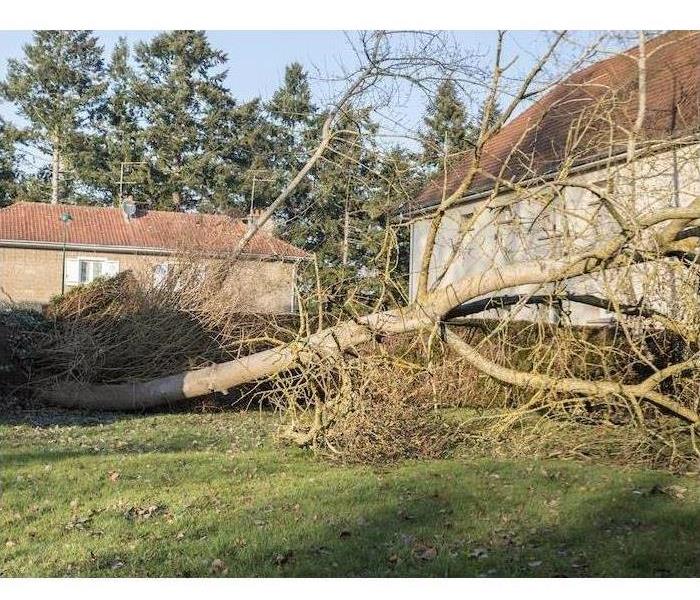 Storm Damage in Illinois
Storm Damage in Illinois
One of the biggest dangers during a driving storm in Carpentersville, IL, can be flying debris. Whether it is a thunderstorm, tornado, hurricane, or gale force winds, the airborne fragments can seriously damage buildings, animals, and people. Your property can sustain damage as the storm rips off siding, shingles, and doors. And far flung debris can crash through windows and puncture outbuildings. Add rain or melting snow to the mix and a roof leak can develop in no time.
Cleaning up after suffering storm damage.
Preventative Steps
Evaluating possible problems and correcting them can limit the amount of damage your building incurs. Check the roof for torn or missing shingles and replace if necessary. This can prevent additional damage to the roofing fabric and a potential roof leak.
Windows and doors can be vulnerable access points for vicious storms. Covering windows with plywood or shutters can often save the panes from breaking and prevent additional water damage.
Assess Properties
Commercial buildings often have outdoor areas with seating, chairs, and trash receptacles. Any of these can turn into deadly projectiles if hurled against the building. If the items cannot be moved indoors, consider anchoring them with straps and cables, or bolting each permanently to the ground.
Trees that are too close to the building or power lines can also be a danger during torrential storms. Not only can the trees fall and cause a damaged roof, but the limbs can break and become missiles. To prevent this, have the trees trimmed away from utility lines and buildings to prevent damage to the structure. If the main body of the tree is taller than the building and close enough to fall, consider having it removed.
Quick Cleanup
No matter how prepared you are, storm damage such as a roof leak can still occur after an unpleasant storm. At the first sign of water damage, contact a storm cleanup and restoration team to assess the property loss. The team can respond immediately and help keep your building open and your business running.
Storm Damage: Is It Tax Deductible?
5/9/2019 (Permalink)
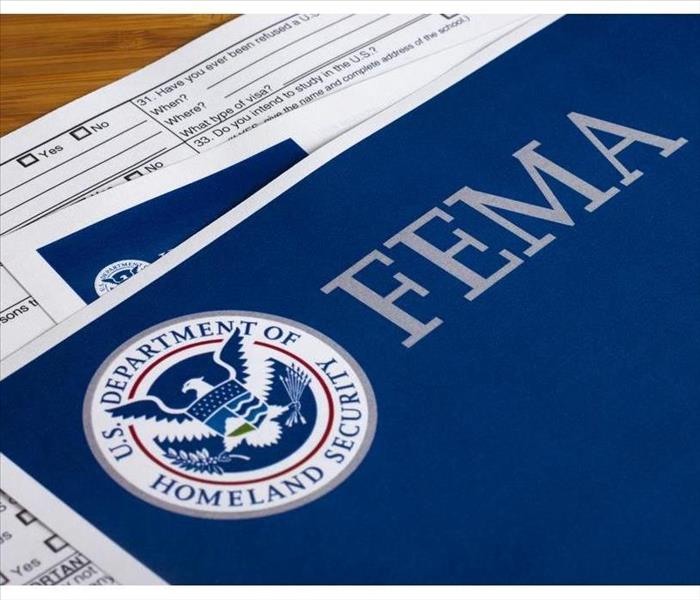 Go to fema.gov page to see if your business was affected in a nationally declared disaster area
Go to fema.gov page to see if your business was affected in a nationally declared disaster area
Storm Damage: Is It Tax Deductible?
Did you know that your Carpentersville,IL, business’s storm damage expenses may be tax deductible? If you filed an insurance claim and the damage was not covered by your commercial policy, it is very likely that you can deduct related expenses from your taxes. Here is the process that you should follow to maximize your deductions.
1. Find out if you are in a disaster area. Go to fema.gov or browse IRS’s Tax Relief in Disaster Situations page to see if your business was affected in a nationally declared disaster area. There may be different, more generous tax rules that apply - some filers even get extensions in this type of circumstance.
2. Calculate your deduction. If you need to, find an online tool or calculator that can help you figure out what your deduction amount should be for nonbusiness storm damage at your commercial building, such as your personal vehicle that was destroyed.
3. Read tax publications. Specifically, you will want to use IRS Publication 547, which deals with disasters, casualties and thefts, to make sure that you are following proper procedures when filing your business taxes and deducting damage expenses.
4. Figure out your next steps. If you want to write off nonbusiness damage that occurred on your property during a storm, you will have to itemize your deductions. You will need to utilize IRS Form 4683 and Schedule A, as well as the specific instructions that go along with these tax papers. If you are simply deducting commercial losses, itemization will not be necessary.
If you need help dealing with your company’s upsetting damage in addition to your taxes, a local commercial storm damage company should be able to help. Whether you need cleanup, document drying or more detailed restoration, such a business can help you get yourself, your team and your commercial building back to normal.
When Does Mold Growth Follow Flooding?
4/26/2019 (Permalink)
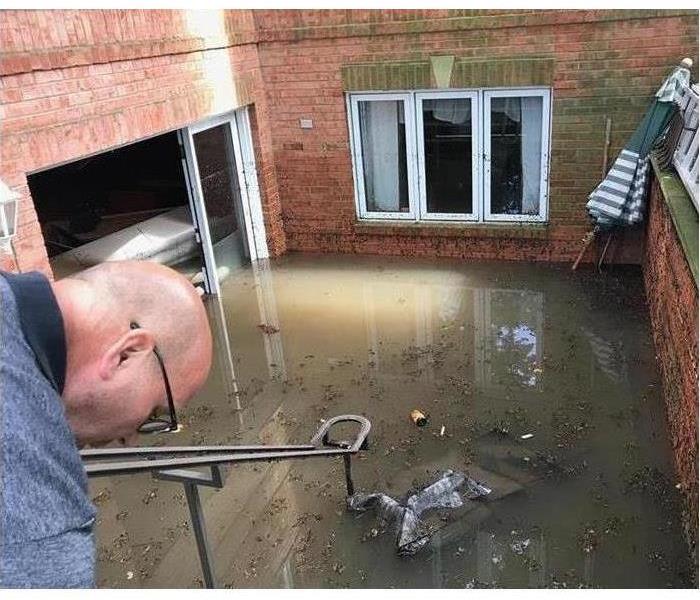 Call SERVPRO of East & West Dundee/SW Barrington Hills for your flooding.
Call SERVPRO of East & West Dundee/SW Barrington Hills for your flooding.
If flooding has recently affected your home in Sleepy Hollow, IL, you are likely to be concerned about the effects of water damage and mold growth. Fungus may develop within just 24 to 48 hours of primary damage. Restoration experts classify flood water as highly contaminated Category Three black water because it may contain solid waste in addition to bacteria, chemicals and other dangerous debris. Learn more about mitigation measures to limit primary storm or water damage and prevent mold.
The First Two Days
The most important mitigation measures should be taken within the first 24 to 48 hours after flooding occurs. If you have remained at home during a flood, contact a mitigation and restoration service as soon as possible. If you have evacuated, schedule a consultation immediately after returning to a damaged residence. It is ideal to have trained professionals take the following steps within the first two days:
- Assess damage
- Extract standing water
- Tear out damaged materials
- Clean and disinfect
These measures can limit primary damage and discourage mold growth. Porous materials such as carpet, drywall and insulation are difficult to disinfect and may pose an elevated mold risk. These materials should be torn out and the affected area cleaned, disinfected and permitted to dry prior to restoration.
The Week After Flooding
In the event of an evacuation, damage may be left standing for longer than 24 to 48 hours. It is important to take the measures listed above as soon as possible to limit damage. Over the next few days, the affected area should be dried. Storm damage mitigation professionals may recommend using air movers, fans or dehumidifiers.
Ideally, mitigation will commence within 24 to 48 hours of water damage. It is crucial to remove standing water as quickly as possible. Maintaining low residual moisture levels afterward can prevent mold growth at a residence in Sleepy Hollow, IL.
Commercial Roof: Ensuring Longevity by Inspecting and Maintaining
2/13/2019 (Permalink)
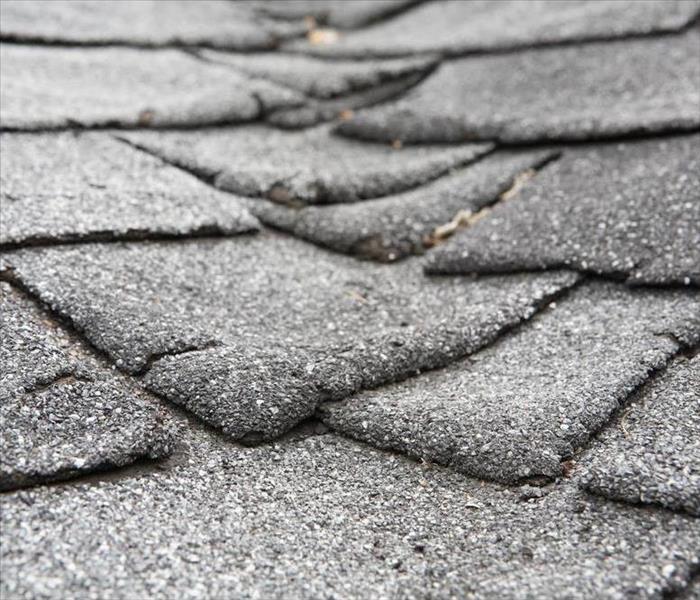 Commercial Roof Damage in West Dundee, IL.
Commercial Roof Damage in West Dundee, IL.
Commercial Roof Damage
Roof damage is one of the leading concerns of all property owners but especially commercial property owners. Business facilities are expansive, and when there is significant damage to the roof, it typically means a bill that is in the tens of thousands. Therefore, owners should consider utilizing a proper inspection and maintenance schedule that focuses on the four areas of common wear and tear.
1. Shingles
Wind damage can lead to missing shingles and exposed underlayment. After every storm, especially those with stronger than usual wind gusts, you or a property manager should inspect the roof for damaged or missing shingles. A good rule of thumb is to search high and low because you may find shingles in the grass alerting you to a more significant issue.
2. Sealant
Water can cause extensive roof damage, and that damage is likely the result of sealant cracking or wear and tear. Inspect your roof at least once a year to ensure that all sealant is intact. If you come across old or cracking sealant, then remove all the old and replace it with new.
3. Gutters
Clogged or congested gutters can lead to water overflowing and seeping under the roof line. This problem can lead to other issues on the interior of your property, such as water staining or drywall cracking. It is best to have a set schedule for gutter cleaning or to hire a service to maintain them.
4. Signs of Age
While maintenance and routine inspections will help to prolong the life of your roof, a roof rebuild or installation is inevitable. Every roof has a projected lifeline and to reach that limit, you should have a restoration specialist in the West Dundee,IL, area on standby for annual inspections or in case of severe storm damage.
Inspecting and maintaining a roof can minimize the risk of severe roof damage. However, nothing is foolproof. To reach the full age of maturity, a roof must be cared for, and keeping an eye on the four areas above will help you do just that.
Storm Preparation Tips for Homeowners
9/21/2018 (Permalink)
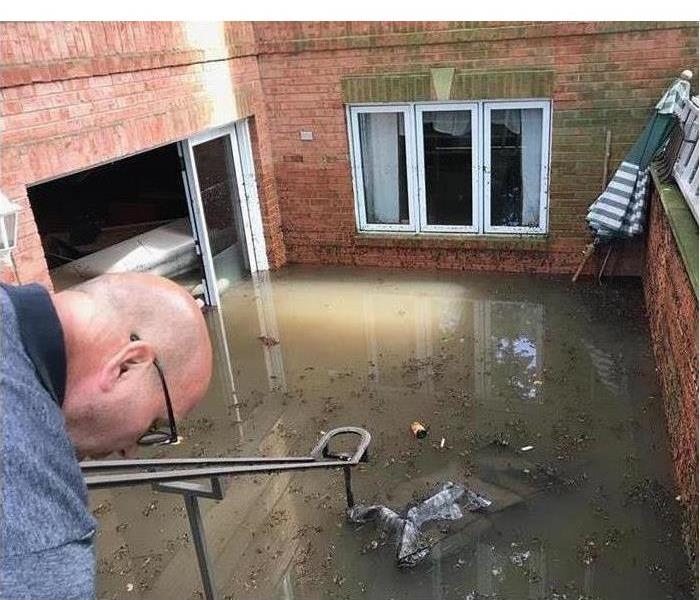 Be prepared for any severe storm in West Dundee, IL
Be prepared for any severe storm in West Dundee, IL
Forewarned is forearmed, as the saying goes, and residents of West Dundee,IL , who monitor the weather are taking the first step toward protecting their homes from the ravages of flood water and other storm and water damage. With free weather apps available, it is easier than ever to stay updated on what Mother Nature is cooking up.
Routine Maintenance
Even before it becomes known that a storm is on the way, there are many proactive measures that homeowners can take to prevent or minimize damage. Investing a bit of time and effort when the weather is calm is likely to deliver benefits when things get dicey.
- Monitor the condition of storm drains to ensure they are not blocked.
- Regularly inspect gutters and downspouts for any debris that impedes drainage.
- Regularly maintain and test sump pumps and submersible pumps to keep them in working order in the event that flood water invades the home.
- Keep tree branches near roofs and windows trimmed.
- Consider elevating appliances commonly found in basements such as washers, dryers, water heaters and dehumidifiers.
Storm Preparation
In the days or perhaps hours before a weather event is predicted, further steps can be taken to prepare for a possible inundation and a flooded building. Monitor the forecast and ramp up efforts to protect the home front.
- Fill the car with gas and assemble medications, food, drinking water, pet supplies, important papers and phones and their chargers in case evacuation is required.
- Develop a communication plan with family members.
- Stay tuned to weather reports for further information and instructions.
- Secure outdoor furniture and other belongings that could be displaced by wind or water.
- Stay indoors during the duration of the storm and do not wade or drive through standing water.
Flood water can be dangerous as well as inconvenient. Keep the focus on preparation and safety. When the time comes for remediation, professionals will be there to help.
What Do You Need To Look for During a Pre-Storm Inspection?
8/20/2018 (Permalink)
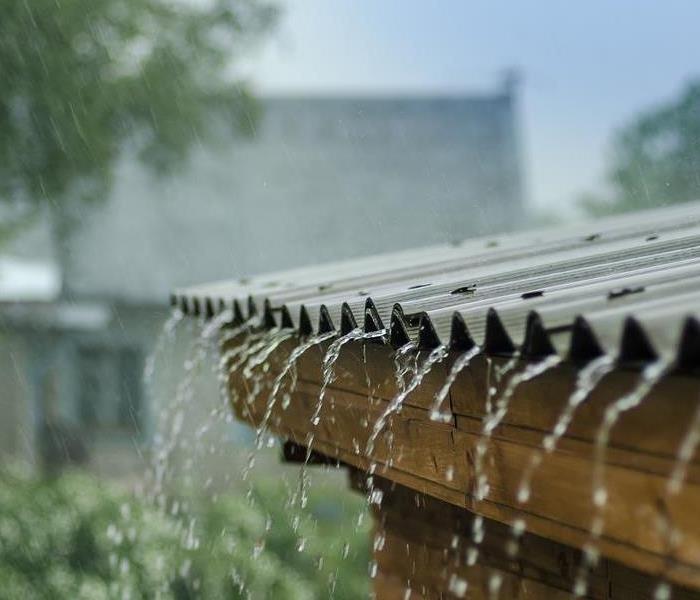 Severe storms passing through cause cause damage to your roof
Severe storms passing through cause cause damage to your roof
Did you know that your commercial property in Carpentersville, IL, may benefit from a pre-storm inspection? Knowing the state of your building can help you better understand the damages a storm causes. This type of assessment is an important part of exterior maintenance. What should you look for as you and your storm remediation expert walk around your property?
Roof Damage
The first area you should look at before a storm passes through is your roof. This system can be quite vulnerable during a storm. Check for signs of existing damage, including the following:
• Loose roofing materials
• Rusted edging
• Blocked vents
Keeping your building maintained can make it more prepared to withstand the onslaught of a storm. Your roofing system, for example, needs to be in top shape to keep water from entering your space.
Siding Problems
Check the siding of your building as well. Here you want to look for signs of material corrosion or degradation. The signs you look for will depend on the type of siding your property has. A bricked façade, for example, may have loose sections or worn grout lines. Vinyl siding may be warped or cracked. As you and your professional walk around the property during your exterior maintenance, try to keep your eye out for anything that isn't as it should be.
Window Weakness
Another important focus of a building inspection is the windows. If the weather stripping around this structure is worn out, you may get water inside your space during even the lightest storms. Check these fixtures for leaky seals and loose panes to make sure your building is as watertight as possible.
Performing exterior maintenance prior to a storm can help you and your building better make it through any bad weather. If you neglect this type of inspection, you may miss early warning signs of weakness that could lead to damage because of high winds and rain.
For more on Carpentersville click here.
Act Quickly When Dealing With Water Damage
6/20/2018 (Permalink)
Water in the home requires quick water cleanup if you want to end up doing some water damage restoration. Flood damage that leaves water in your business can hurt your sales if nothing is done. Here's a quick guide to the mitigation of your water cleanup project.
First Step in Water Cleanup
Water damage is a serious problem if not taken care of. The first thing you should so is to disconnect the power from the area containing water in your business. Remove all electronics from the area and begin moving furniture to somewhere with some air movement so they can start drying.
Extract Fluid
Once you have the area cleaned out, you can start removing the water in the home. A pump can be purchased to remove large amounts of water. Flood damage that dumps a large quantity of water in your business has to be taken care of quickly. A shop vac that can hold water is another indispensable tool in stopping water damage from spreading.
As soon as you become aware of any water damage in your home or business, you should contact a professional water damage restoration expert. They will know what they are doing and make sure that your place doesn't get ruined from the effects of water damage.
Lightening Strikes Again!
6/11/2018 (Permalink)
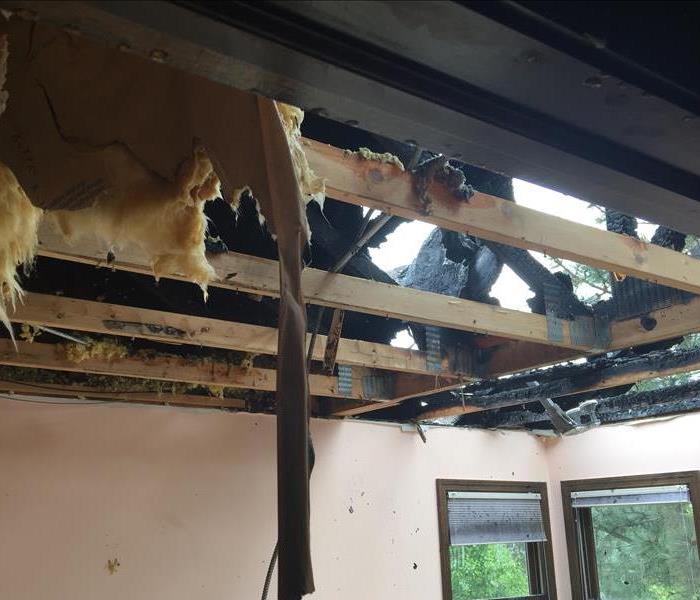 Ceiling/Roof damage
Ceiling/Roof damage
Most houses are filled with many potential routes for lightning to follow in its journey. This can include gas and water pipes, electric lines, phone lines, cable TV/internet lines, gutters, downspouts, metal window frames - anything conductive in a house is 'fair game' for the lightning to follow. In this situation, lightening struck this home causing a fire. With that fire, storm water was then able to fill the home damaging pretty . much anything in it's path. These homeowners called us the next morning when the storms had gone. Our crews got to work immediately by stabilizing the structure. Once they put a tarp on the roof, they then started going through the customers contents helping them salvage what they could. Next, we met with the insurance adjuster on site and went over all of the damage and got a list of everything that needed to be done. The process with a fire can be very overwhelming but we appreciate our customers faith in us!
Flooded Home
6/11/2018 (Permalink)
When there are heavy rainfalls, we never know if water will intrude in to our homes or businesses. We were able to get a crew to this home and start the drying process as soon as the waters receded.
The hardwood and baseboard as well as the drywall 2 feet up had to be removed due to the amount of saturation and condition of the water. Sometimes hardwood can be saved but in this case, it had been saturated for far too long, leaving it unsalvageable.
After removing the water with our extraction units, we set equipment and were able to get the damaged rooms dry within 3 days, leaving our homeowners very thankful for SERVPRO of East & Wet Dundee/SW Barrington Hills to help out during the crisis.
Incoming Water from Ceiling
6/11/2018 (Permalink)
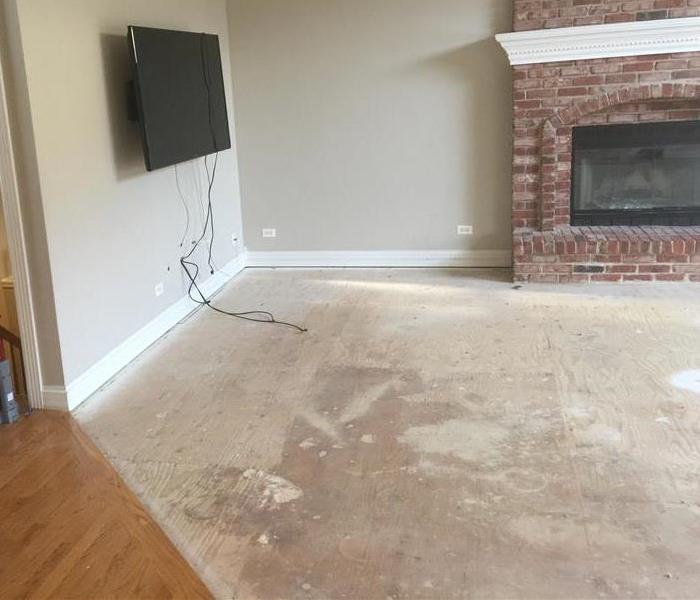 Storm water came in through the roof/ceiling causing damage throughout
Storm water came in through the roof/ceiling causing damage throughout
A few months ago, in this residence a severe thunderstorm had passed through town. The wind had torn off shingles and allowed rain water to flood into the home. The walls, ceiling, and floor sustained large amounts of water. Our teams acted quickly and we were able to get on site and set equipment to begin to dry the structure, but the damage had been done. The hardwood was saturated beyond repair and the ceiling had collapsed leaving drywall and insulation debris scattered. After several days of drying and cleaningSERVPRO of East & West Dundee/SW Barrington Hills had everything out and the home was ready for the repairs to begin. It's never fun when disaster strikes, but in your time of need we are always there.

 24/7 Emergency Service
24/7 Emergency Service
